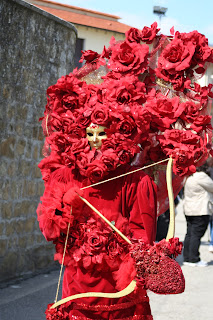Castiglion Fibocchi (AR), from the 1st to the 8th February.
Castiglion Fibocchi is a small town in the province of Arezzo, whose name derives from the Latin "castellum", that is fortified and "Filis Bocchi", which literally means sons of Bocco. Probably the name dates back to the time of the Lord Ottaviano de 'Pazzi, Bocco said, for a deformation of the face around 1190.
Many stories tell of fabulous medieval celebrations in the country before Lent, so about ten years ago has been restored this ancient tradition.
The festival, now in its seventeenth edition, is organized into two days: more than two hundred listed parade through the streets, alleys and picturesque squares of the village, hidden from precious masks and dressed in very elegant, luxurious costumes.
It's a fascinating show, two days when the atmosphere is magical timeless. The masks reminiscent of the most festive carnival of Venice, but the atmosphere is more intimate, where masks are waiting on street corners to surprise and wrap the visitors with their beautiful and original costumes.

The show begins at 3:00 p.m with the opening of food stands, at 4:30 p.m it continues the opening speech of the King Bocco his court and the parade of masks begins for all the roads of the village. All surrounded by happiness of many street artists and skill of Madonnari, depicting the masks of the Sons of Bocco.
How to reach Castiglion Fibocchi: for that is from Florence (A1) exit at Valdarno and follow the signs to Loro Ciuffenna and then to San Giustino.
For those coming from Rome (A1), exit at Arezzo and take the Seven Bridges, following the signs for Ponte a Buriano and then to Castiglion Fibocchi.
 Castiglion Fibocchi è una piccola cittadina in provincia di Arezzo, il cui nome deriva deriva dal latino " castellum", cioè luogo fortificato e da " filis Bocchi", che letteralmente significa figli di Bocco. Probabilmente il toponimo risale al tempo del Signore Ottaviano de' Pazzi, detto Bocco, per una deformazione al viso intorno al 1190.
Castiglion Fibocchi è una piccola cittadina in provincia di Arezzo, il cui nome deriva deriva dal latino " castellum", cioè luogo fortificato e da " filis Bocchi", che letteralmente significa figli di Bocco. Probabilmente il toponimo risale al tempo del Signore Ottaviano de' Pazzi, detto Bocco, per una deformazione al viso intorno al 1190.Molte novelle medievali raccontano di favolosi festeggiamenti in paese prima della Quaresima, così una diecina di anni fa è stata ripristinata questa antica tradizione.
I festeggiamenti, arrivati ormai alla diciassettesima edizione, quest'anno si articolano in due giornate: oltre duecento figuranti sfilano per le stradine, vicoli e pittoresche piazzette del borgo, celati da preziose maschere e vestiti con costumi molto eleganti, sfarzosi e curati nei minimi dettagli.
 È uno spettacolo suggestivo; due giornate in cui si respira un'atmosfera incantata fuori dal tempo. Le maschere ricordano il più festoso carnevale di Venezia, ma l'ambiente è più intimo, più raccolto, in cui le maschere attendono agli angoli delle strade per stupire ed incartare i visitatori con i loro meravigliosi ed originali costumi.
È uno spettacolo suggestivo; due giornate in cui si respira un'atmosfera incantata fuori dal tempo. Le maschere ricordano il più festoso carnevale di Venezia, ma l'ambiente è più intimo, più raccolto, in cui le maschere attendono agli angoli delle strade per stupire ed incartare i visitatori con i loro meravigliosi ed originali costumi.Lo spettacolo inizia alle ore 14.30 con l'apertura degli stands gastronomici, alle 16.00 prosegue il discorso di apertura del Re Bocco alla sua corte ed inizia la sfilata dei tutte le maschere per le strade del piccolo centro. Il tutto contornato dall'allegria di svariati artisti di strada e dalla bravura dei Madonnari, che riproducono le maschere dei Figli di Bocco.
Come raggiungere Castiglion Fibocchi: per che viene da Firenze(A1) uscire al casello Valdarno e seguire le indicazioni per Loro Ciuffenna e successivamente per S. Giustino.
Per chi viene da Roma ( A1), uscire al casello Arezzo e prendere la Sette Ponti, seguendo le indicazioni per Ponte a Buriano e successivamente per Castiglion Fibocchi.



